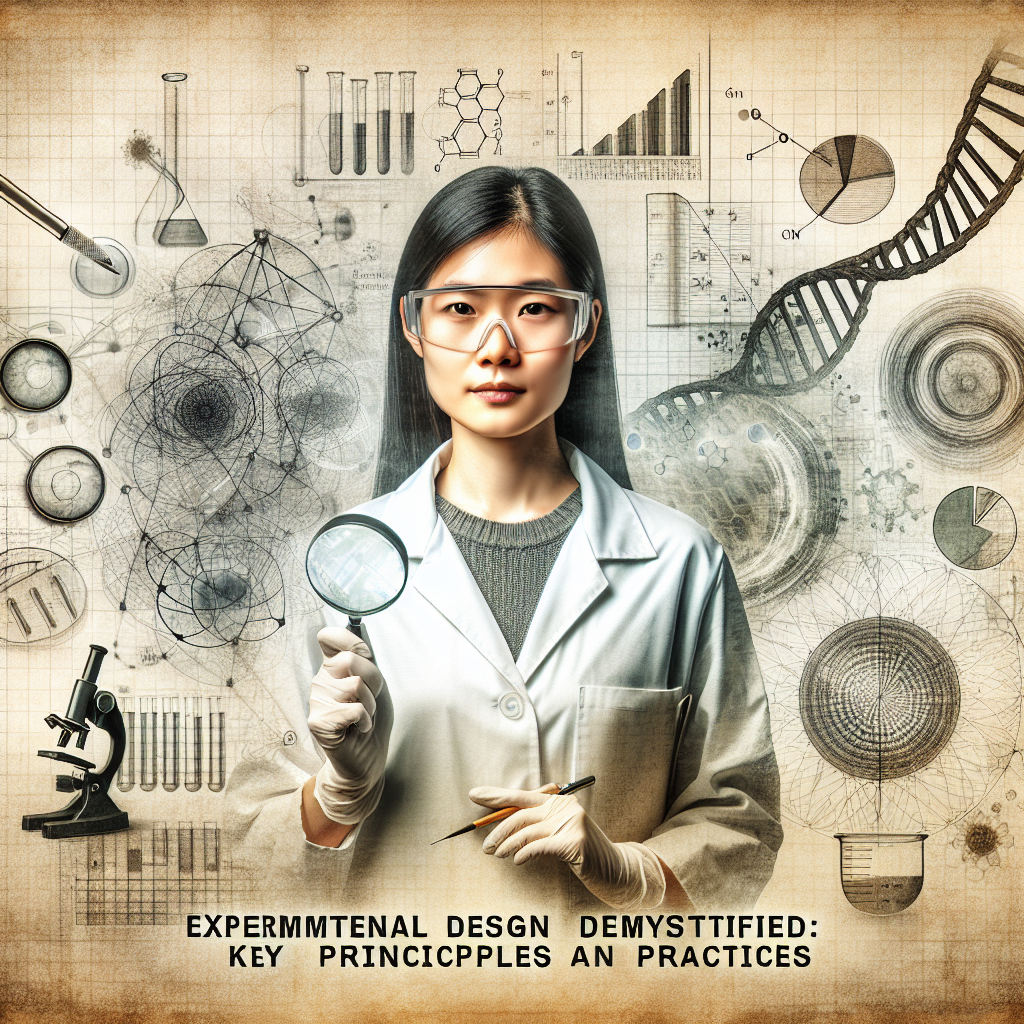
Introduction
Welcome to the fascinating world of experimental design! Whether you’re developing groundbreaking medical research, crafting compelling marketing strategies, or striving for organizational improvement, the principles of experimental design can serve as powerful tools in your arsenal. This comprehensive guide, "Experimental Design Demystified: Key Principles and Practices," aims to strip away the complexities surrounding experimental design. Instead, we’ll shed light on its transformative potential, showcasing how a robust understanding of key concepts can lead to better data, impactful results, and clearer insights.
Imagine launching a new product without testing its market fit or rolling out a health intervention without assessing its impact! The importance of structured experimentation shouldn’t be underestimated. But fear not — the complexities of experimental design can be untangled, revealing its foundational principles and practical applications.
In this article, we will explore the nuances of experimental design, dissect its various elements, and present case studies that illustrate its real-world utility. By the end, you will not only grasp the essential principles of experimental design but also feel empowered to incorporate them into your projects.
Understanding Experimental Design: The Basics
What is Experimental Design?
At its core, experimental design refers to the methodology and planning behind conducting experiments to test hypotheses. It enables researchers to draw causal conclusions from their observations — a critical aspect of any scientific inquiry.
For practical purposes, think of experimental design as a roadmap to achieving concrete results from your experiments. It involves planning how to collect data effectively, ensuring quantitative or qualitative measurements are valid, reliable, and applicable to your research questions.
Key Components of Experimental Design
Independent and Dependent Variables:
- The independent variable is the factor you manipulate, while the dependent variable is what you measure. Understanding their relationship is pivotal in experimental design.
Control Groups:
- Control groups help to establish a baseline. They remain unaffected by the independent variable, thereby providing a point of comparison.
Randomization:
- Randomly assigning subjects to different groups mitigates bias, allowing for a more objective analysis of results.
- Replication:
- Replication ensures results are consistent. Repeating experiments strengthens the validity of conclusions drawn.
Table: Key Terminology in Experimental Design
| Term | Definition |
|---|---|
| Independent Variable | The variable that is manipulated in an experiment. |
| Dependent Variable | The variable that is measured to determine effect. |
| Control Group | A group that does not receive the experimental treatment. |
| Randomization | The random assignment of participants to different groups. |
| Replication | Repeating a study to confirm findings. |
Core Principles of Experimental Design
1. Clarity of Purpose
Before diving into any experiment, clarify your purpose. What question are you trying to answer? For instance, a pharmaceutical study should specifically outline its aim—like testing the efficacy of a new drug over a placebo.
2. Defining Hypotheses
A well-defined hypothesis serves as the foundation of experimental design. It should be clear, measurable, and directly related to the independent and dependent variables.
3. Balancing Internal and External Validity
- Internal Validity refers to the credibility of your study’s results. Are the observed effects truly due to the treatment applied?
- External Validity pertains to the generalizability of your findings. Can you apply your results to larger populations or different settings?
Striking a balance between these two forms of validity is crucial. A study with high internal validity might be so controlled that the findings cannot be generalized, and vice versa.
4. Sample Size Considerations
Determining an appropriate sample size is essential for achieving reliable results. Too few participants can lead to irrelevant conclusions, while too many can introduce unnecessary complexity. Statistical power analyses can assist in determining the right sample size.
Case Study: Medical Research Study
Scenario: Testing a New Vaccine
In a recent study aimed at evaluating a new vaccine’s efficacy, researchers defined clear hypotheses, applied randomization among subjects, and established a treatment and control group. The study effectively highlighted the importance of a sufficiently large sample size, employing over 10,000 participants to ensure reliable data. As a result, the findings not only demonstrated the vaccine’s effectiveness but also underlined its broader applicability across diverse demographics.
Analysis
This study exemplifies the principles of experimental design, showcasing clarity of purpose, hypothesis formulation, and attention to sample size.
Practical Applications of Experimental Design
Industries Benefiting from Experimental Design
Healthcare:
- Clinical trials serve as the backbone of new treatment evaluation, ensuring that interventions are both safe and effective before broad implementation.
Marketing:
- A/B testing allows companies to determine which advertising strategies resonate more with target audiences, optimizing their campaigns for greater impact.
- Psychology:
- Experiments in social psychology help in understanding human behavior through controlled studies, driving insights into societal trends.
Real-world Example: A/B Testing in Marketing
Company X’s Campaign
Company X implemented A/B tests to analyze which email marketing subject lines generated higher open rates. They created two email versions—one with an intriguing question and another with a straightforward offer. By analyzing which version garnered more engagement, they successfully improved their overall click-through rates by 20%.
Analysis
Here, the use of experimental design principles allowed for objective measurement of a marketing strategy’s effectiveness, illustrating that careful planning can yield significant boosts in performance.
Advanced Concepts in Experimental Design
1. Factorial Designs
Factorial designs are beneficial when exploring multiple independent variables and their interactions. By combining different levels of each variable in a comprehensive design, researchers can assess not only the main effects but also the interaction effects between variables.
2. Blind and Double-Blind Studies
Blind studies help to reduce bias, as participants are unaware of which group they belong to. Double-blind studies take this a step further, ensuring that both participants and researchers are unaware of the assigned groups, eliminating potential biases in data collection and interpretation.
Case Study: Double-Blind Study in Pharmaceuticals
In testing a new antidepressant, researchers implemented a double-blind approach to eliminate bias during evaluation. Both participants and administering physicians were unaware of which subjects received the drug versus a placebo. The results led to a significant uncovering of the drug’s effectiveness, further validating this robust methodological approach.
Analysis
The double-blind design increased the study’s credibility, showcasing the effectiveness of rigorous experimental design methodologies.
Conclusion: Empowering Your Experimental Design Journey
As we’ve explored throughout this article, understanding experimental design is crucial in transforming your thoughts and ideas into reliable data-driven insights. Whether you’re an academic researcher, a marketer, or an organizational leader, leveraging these principles can enhance your decision-making and bolster your outcomes.
By grasping the key components — clarity of purpose, hypothesis development, randomization, and replication — you will establish a sound foundation for effective outcomes. Remember, Experimental Design Demystified: Key Principles and Practices is not just a theoretical framework; it’s an essential toolkit for success.
Take actionable steps today: reflect on your current projects and consider how you can integrate these principles into your research or business practices. The journey has just begun!
FAQs
1. What is the primary purpose of experimental design?
The primary purpose is to test hypotheses through systematic investigation, allowing researchers to infer causal relationships and draw valid conclusions from observed data.
2. How do I know if my sample size is sufficient?
Statistical power analysis helps determine the adequate sample size for reliable results. Tools and calculators are available to assist with this analysis.
3. What is the difference between internal and external validity?
Internal validity assesses the credibility of study results, while external validity evaluates the generalizability of those results to other settings and populations.
4. How does randomization help in experimental design?
Randomization minimizes bias by ensuring that participants are equally distributed across treatment groups, enhancing the reliability of the results.
5. Can experimental design principles be applied in non-scientific fields?
Absolutely! These principles are versatile and can be utilized in various fields, including marketing, education, and social sciences, enhancing decision-making and outcomes.
In summary, this comprehensive exploration of Experimental Design Demystified: Key Principles and Practices not only provides foundational knowledge but also serves as an actionable guide, empowering readers to adeptly navigate the complexities of experimental design in their respective fields. Whether you’re a student, researcher, or professional, these principles will enhance your ability to make informed decisions and achieve impactful results.














